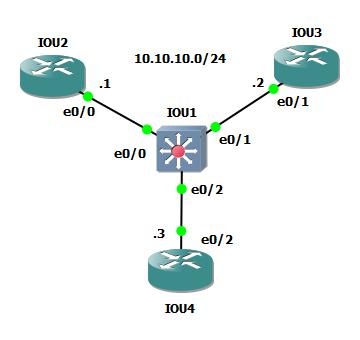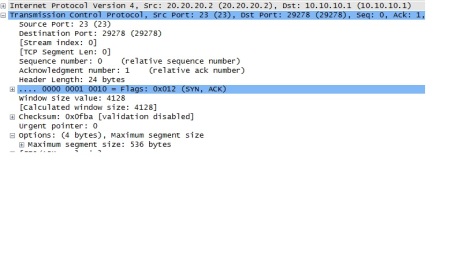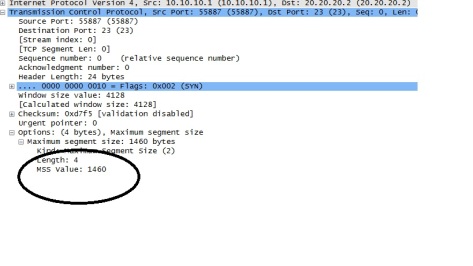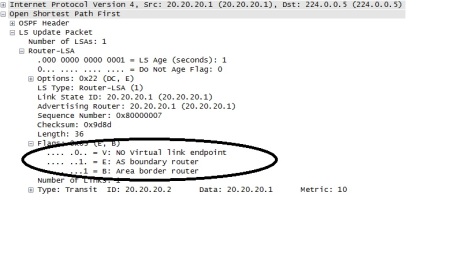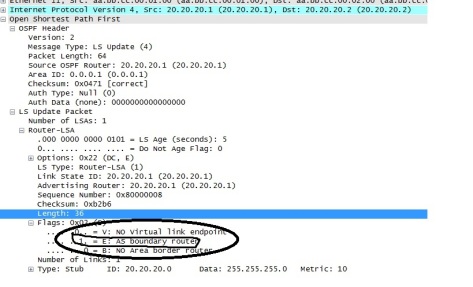So back to OSPF again , this time i am going deal with Forwarding address and why we need forwarding address ,what are the advantages of it and what happens in NSSA ?
As we all know the FA would be set in the following conditions:
Snippets from www.cisco.com
- OSPF is enabled on the ASBR’s next hop interface AND
- ASBR’s next hop interface is non-passive under OSPF AND
- ASBR’s next hop interface is not point-to-point AND
- ASBR’s next hop interface is not point-to-multipoint AND
- ASBR’s next hop interface address falls under the network range specified in the router ospf command.
“But if we have NSSA in OSPF the FA is set by default in the NSSA ASBR unless the NSSA ABR suppresses the FA when it converts the type 7 LSA to type 5 LSA”
We are redistributing a prefix in IOU1 so that it can generate a type 7 NSSA LSA and the NSSA can generate type 5 LSA to the other areas .
So here is our scenario for this topic: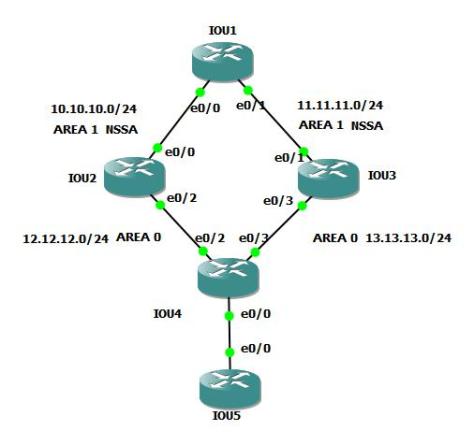
” As we all know the NSSA ABR with the highest router-id converts the Type 7 LSA to Type 5 LSA though both the NSSA ABR’s can convert if we have nssa-translate always command in both the ABR’s .So in this case the IOU3 converts the Type 7 to Type 5 LSA “
The configurations of the routers are as follows:
OSPF is configured on the interfaces directly without using Network command.
IOU1#show run | s ospf
ip ospf 1 area 1
ip ospf 1 area 1
router ospf 1
area 1 nssa
redistribute connected subnets route-map test
IOU1#show route-map test
route-map test, permit, sequence 10
Match clauses:
ip address (access-lists): 10
Set clauses:
Policy routing matches: 0 packets, 0 bytes
IOU1#show ip access-lists
Standard IP access list 10
10 permit 1.1.1.0, wildcard bits 0.0.0.255 (1 match)
IOU2#sh run | s ospf
ip ospf 1 area 1
ip ospf 1 area 0
router ospf 1
area 1 nssa
IOU3#show run | s ospf
ip ospf 1 area 1
ip ospf cost 40
ip ospf 1 area 0
router ospf 1
area 1 nssa
IOU4#show run | s ospf
ip ospf 1 area 2
ip ospf 1 area 0
ip ospf 1 area 0
router ospf 1
IOU5#show run | s ospf
ip ospf 1 area 2
router ospf 1
So you can see that IOU1 is generating the type 7 NSSA external LSA.
IOU1#show ip ospf database | b Type-7
Type-7 AS External Link States (Area 1)
Link ID ADV Router Age Seq# Checksum Tag
1.1.1.0 1.1.1.1 1964 0x80000003 0x00A8C2 0
On the router IOU2 we can see both the type 7 LSA and the type 5 LSA since the NSSA ABR router IOU3 converts the type 7 to type 5 LSA.
IOU2#sh ip ospf database | b External
Type-7 AS External Link States (Area 1)
Link ID ADV Router Age Seq# Checksum Tag
1.1.1.0 1.1.1.1 37 0x80000004 0x00A6C3 0
Type-5 AS External Link States
Link ID ADV Router Age Seq# Checksum Tag
1.1.1.0 13.13.13.1 51 0x80000004 0x001A36 0
As i mentioned previously if we can analyze the external LSA’s you have the FA set by the NSSA ASBR. The ASBR choosed the highest active NSSA IP address as the FA.in this case it chose 11.11.11.1 since its higher than 10.10.10.1
IOU2#show ip ospf database nssa-external
OSPF Router with ID (12.12.12.1) (Process ID 1)
Type-7 AS External Link States (Area 1)
Routing Bit Set on this LSA in topology Base with MTID 0
LS age: 277
Options: (No TOS-capability, Type 7/5 translation, DC, Upward)
LS Type: AS External Link
Link State ID: 1.1.1.0 (External Network Number )
Advertising Router: 1.1.1.1
LS Seq Number: 80000004
Checksum: 0xA6C3
Length: 36
Network Mask: /24
Metric Type: 2 (Larger than any link state path)
MTID: 0
Metric: 20
Forward Address: 11.11.11.1
External Route Tag: 0
If we analyse the IOU3 you would have the NSSA external type 7 LSA and type 5 LSA advertised by itself.
IOU3#show ip ospf database | b External
Type-7 AS External Link States (Area 1)
Link ID ADV Router Age Seq# Checksum Tag
1.1.1.0 1.1.1.1 382 0x80000004 0x00A6C3 0
Type-5 AS External Link States
Link ID ADV Router Age Seq# Checksum Tag
1.1.1.0 13.13.13.1 394 0x80000004 0x001A36 0
Now we will see the OSPF database of IOU4 to see which path it takes to reach 1.1.1.1 . We can see the external as advertised by IOU3 since that was the ABR which converted type 7 to type 5.
IOU4#show ip ospf database external
OSPF Router with ID (14.14.14.1) (Process ID 1)
Type-5 AS External Link States
Routing Bit Set on this LSA in topology Base with MTID 0
LS age: 1608
Options: (No TOS-capability, DC, Upward)
LS Type: AS External Link
Link State ID: 1.1.1.0 (External Network Number )
Advertising Router: 13.13.13.1
LS Seq Number: 80000006
Checksum: 0x1638
Length: 36
Network Mask: /24
Metric Type: 2 (Larger than any link state path)
MTID: 0
Metric: 20
Forward Address: 11.11.11.1
External Route Tag: 0
In the routing table we can see that it takes the path through the NSSA ABR IOU3. Since the default external type is E2 we see 2 metrics here. The metric 20 is the metric to reach the external prefix and the forward metric is the metric to reach the Forwarding address.
So if we have FA set, the least cost to reach the FA is preferred irrespective of who is the NSSA ABR which converts the type 7 to type 5.
Now since the cost to the FA is same for IOU4 through both IOU2 and IOU3 it prefers IOU3 since that advertised the type 5.
IOU4#show ip route 1.1.1.1
Routing entry for 1.1.1.0/24
Known via “ospf 1”, distance 110, metric 20, type extern 2, forward metric 20
Last update from 13.13.13.1 on Ethernet0/3, 00:00:02 ago
Routing Descriptor Blocks:
* 13.13.13.1, from 13.13.13.1, 00:00:02 ago, via Ethernet0/3
Route metric is 20, traffic share count is 1
*** An external route with FA set will be used in the routing table only if the FA is reachable through an INTER-AREA or an INTRA- AREA**
In our case its inter-area.
IOU4#show ip route 11.11.11.1
Routing entry for 11.11.11.0/24
Known via “ospf 1”, distance 110, metric 20, type inter area
Last update from 13.13.13.1 on Ethernet0/3, 00:05:35 ago
Routing Descriptor Blocks:
* 13.13.13.1, from 13.13.13.1, 00:05:35 ago, via Ethernet0/3
Route metric is 20, traffic share count is 1
What would happen if i change the cost on IOU4 or IOU3 ? we can change the OSPF cost on E0/3 in IOU4 or E0/1 in IOU3 . i am changing the cost in IOU3 now.
IOU3(config)#int ethernet 0/1
IOU3(config-if)#ip ospf cost 40
IOU3(config-if)#
IOU3#wr m
*Dec 2 01:20:12.591: %SYS-5-CONFIG_I: Configured from console by console
IOU3#wr mem
Building configuration…
Now after the changing the cost on E0/1 in IOU3, the external route in IOU4 is taking the path through IOU2 why?
IOU4#show ip route 1.1.1.1
Routing entry for 1.1.1.0/24
Known via “ospf 1”, distance 110, metric 20, type extern 2, forward metric 30
Last update from 12.12.12.1 on Ethernet0/2, 00:00:03 ago
Routing Descriptor Blocks:
* 12.12.12.1, from 13.13.13.1, 00:00:03 ago, via Ethernet0/2
Route metric is 20, traffic share count is 1
Since the cost to the FA is 30 through E0/2 it prefers IOU2 though IOU3 generated type 5 LSA.
IOU4#show ip route 11.11.11.1
Routing entry for 11.11.11.0/24
Known via “ospf 1”, distance 110, metric 30, type inter area
Last update from 12.12.12.1 on Ethernet0/2, 00:01:56 ago
Routing Descriptor Blocks:
* 12.12.12.1, from 12.12.12.1, 00:01:56 ago, via Ethernet0/2
Route metric is 30, traffic share count is 1
As we can see the metric advertised by IOU3 to reach the FA is 40 .
LS age: 417
Options: (No TOS-capability, DC, Upward)
LS Type: Summary Links(Network)
Link State ID: 11.11.11.0 (summary Network Number)
Advertising Router: 13.13.13.1
LS Seq Number: 8000000B
Checksum: 0x3A87
Length: 28
Network Mask: /24
MTID: 0 Metric: 40
Now we are moving to IOU5 to check which route it prefers. As you can see it prefers IOU2 due to the cost to the FA is less through that path.
IOU5#show ip route 1.1.1.1
Routing entry for 1.1.1.0/24
Known via “ospf 1”, distance 110, metric 20, type extern 2, forward metric 40
Last update from 14.14.14.1 on Ethernet0/0, 00:43:02 ago
Routing Descriptor Blocks:
* 14.14.14.1, from 13.13.13.1, 00:43:02 ago, via Ethernet0/0
Route metric is 20, traffic share count is 1
IOU5#traceroute 1.1.1.1 num
Type escape sequence to abort.
Tracing the route to 1.1.1.1
VRF info: (vrf in name/id, vrf out name/id)
1 14.14.14.1 1 msec 0 msec 1 msec
2 12.12.12.1 1 msec 0 msec 1 msec
3 10.10.10.1 2 msec 2 msec 1 msec
IOU5#
“So the conclusion is if we have FA set, the least cost to the FA is preferred “.
Points to remember :
- If we have Forwarding address set in the External route the least cost to the forwarding address is preferred no matter which NSSA ABR converts the type 7 to type 5 LSA
- The Forwarding address should be reachable through a INTER-AREA or INTRA AREA to be moved to the routing table.
- The Forward metric in the EXTERNAL TYPE 2 denotes the cost to the FA .
- In EXTERNAL TYPE 1 the cost the external network plus the cost to the FA is merged together.
PART 2 of the Forwarding address will be continued in the next post 🙂

